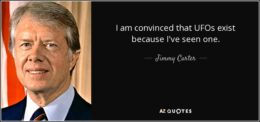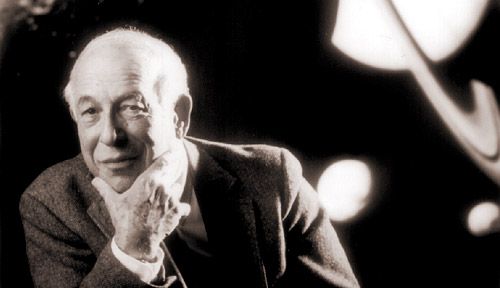by Charles Lear, author of “The Flying Saucer Investigators.”
 According to the sighting report forms (pages 2 and 4 of pdf) filled out by Georgia Governor Jimmy Carter for the National Investigations Committee on Aerial Phenomena and the International UFO Bureau on September 18, 1973, he and 10-12 other men observed a UFO he described as a light that was “at one time, as bright as the moon” for 10-12 minutes in Leary, Georgia. According to the form, they were outside waiting for a 7:30 p.m. Lions Club meeting to start. During Carter’s presidential campaign in 1976, a reporter from the National Enquirer asked him if he would release all the information the government had on UFOs if he was elected. He is quoted in the June 8, 1976 edition of the Enquirer as saying “If I become President, I’ll make every piece of information this country has about UFO sightings available to the public and the scientists. I’m convinced that UFOs exist because I have seen one.” When he was elected, the White House began receiving letters from UFO enthusiasts who wanted to know when he was going to make good on his promise. One of these is included in the article by Philip J. Klass, headlined “NASA, the White House, and UFOs” published in the Spring/Summer 1978 Skeptical Inquirer:
According to the sighting report forms (pages 2 and 4 of pdf) filled out by Georgia Governor Jimmy Carter for the National Investigations Committee on Aerial Phenomena and the International UFO Bureau on September 18, 1973, he and 10-12 other men observed a UFO he described as a light that was “at one time, as bright as the moon” for 10-12 minutes in Leary, Georgia. According to the form, they were outside waiting for a 7:30 p.m. Lions Club meeting to start. During Carter’s presidential campaign in 1976, a reporter from the National Enquirer asked him if he would release all the information the government had on UFOs if he was elected. He is quoted in the June 8, 1976 edition of the Enquirer as saying “If I become President, I’ll make every piece of information this country has about UFO sightings available to the public and the scientists. I’m convinced that UFOs exist because I have seen one.” When he was elected, the White House began receiving letters from UFO enthusiasts who wanted to know when he was going to make good on his promise. One of these is included in the article by Philip J. Klass, headlined “NASA, the White House, and UFOs” published in the Spring/Summer 1978 Skeptical Inquirer:
Dear Mr. President,
During your presidential campaign; you had made the commitment [sic], that you, sir, would release, to the American people, all of the U.F.O. secrecy now held in the archives of the federal government, consisting of various agencies; your article with this commitment [sic] appeared in the June 8, 1976 issue of “The National Enquirer” newspaper. I have voted for you, mainly for this reason. I do faithfully hope you will not disappoint me, as one of millions of citizens who has voted for you . . .
 Richard C. Henry of the Department of Physics and Astronomy at Johns Hopkins University, who was a deputy to NASA’s Director of the Astrophysics Division Bland Norris at the time, wrote an essay about the situation. Henry was also an astrophysics consultant to the Aerial Phenomena Research Organization. According to Henry in his essay titled “UFOs and NASA” published in the Journal of Scientific Exploration Vol. 2, No. 2, pp. 93-102, 1988, this situation prompted White House Scientific Advisor Frank Press to reach out to NASA in a letter, and Henry included it as Appendix 1. NASA now had what Henry described as a “hot potato” in its hands and getting rid of it would mean, in essence, saying no to the President.
Richard C. Henry of the Department of Physics and Astronomy at Johns Hopkins University, who was a deputy to NASA’s Director of the Astrophysics Division Bland Norris at the time, wrote an essay about the situation. Henry was also an astrophysics consultant to the Aerial Phenomena Research Organization. According to Henry in his essay titled “UFOs and NASA” published in the Journal of Scientific Exploration Vol. 2, No. 2, pp. 93-102, 1988, this situation prompted White House Scientific Advisor Frank Press to reach out to NASA in a letter, and Henry included it as Appendix 1. NASA now had what Henry described as a “hot potato” in its hands and getting rid of it would mean, in essence, saying no to the President.
The letter, dated July 21, 1977, is addressed to NASA Administrator Robert Frosch. It begins with this:
Dear Bob:
We have discovered that the White House is becoming the focal point for an increasing number of inquiries concerning UFO’s. As you know, there appears to be a national revival of interest in the matter with a younger generation becoming involved. Those of us in the Executive Office are ill-equipped to handle these kinds of inquiries.
He wrote that it seemed to him “that the focal point for the UFO question ought to be in NASA.” He makes two recommendations. The first is that a small panel be put together at NASA to see if there had been any significant findings since the Condan [sic] report and that high-profile people with an interest in the problem such as Carl Sagan be involved as “this is a public relations problem as much as anything else.” The second is that “NASA become the focal point for general correspondence and that those inquiries which come to the White House be sent to the designated desk at NASA.”
The reply, signed by Frosch, wasn’t sent until September 6, 1977, and is included as Appendix 2. In the letter, it is explained that the Air Force “concluded, in the absence of significant findings, that the program warranted no more than routine form letter answers to inquiries and has been handling the program in that manner since about 1970,” and that NASA used form letters as well. It is pointed out that, while this is economical, it results in frustration for those “making what they consider to be serious inquiries.” It is agreed that a NASA panel might “possibly discover new significant findings” but before committing to creating such a panel, NASA needed assurance that an inquiry was justified. It is suggested that this could be done by assigning someone to review UFO reports from the last ten years who would then make a recommendation. The letter closes with the promise that such an action would be taken if Press concurred. Press did concur in the course of a letter dated September 14, 1977, included as Appendix 4.

According to Henry, word leaked out that NASA was designating him as the project officer for UFOs, and this resulted in Klass sending him a copy of his 1976 book UFOs Explained marked “To Richard Henry with the hope this may shed useful light on an old controversy-And help you and NASA avoid the fate of “Tar Baby” and the late Dr. Ed Condon!” He also says that Robert Sheaffer wrote him using Committee for the Scientific Investigation of Claims of the Paranormal letterheaded stationary warning him to “be prepared to be deluged by mail from every kook and crackpot in the country, and even worse, be prepared for letters from the ‘scientific’ UFO investigators, who will appear reasonable and sane enough, yet are true believers in every sense of the word . . .” Henry replied on October 5, 1977, that he hadn’t been assigned.
Henry explains on page 96 that NASA has a unique vertical management structure and that every piece of correspondence that comes in is copied and sent out to the lowest level members of the distribution chain for which the secretary feels the information would be relevant. A draft reply is written and this is sent up the chain and can be rewritten or edited at any point until it’s finally signed and mailed by the addressee, who often reads the original letter for the first time. By the time the reply is sent out, it’s not clear at which point the reply was finalized, and in matters of policy, it’s not clear where any given policy originated.
In this case, this worked out to NASA’s advantage, as the decision to say no to the President couldn’t be blamed on any one person. In a letter to Press signed by Frosch, it is explained that NASA was going to continue dealing with UFO inquiries as it had been but was open to using NASA labs to “analyze and report upon an otherwise unexplained organic or inorganic sample” and was prepared “to respond to any bona fide physical evidence from credible sources.” Due to “an absence of tangible or physical evidence available for thorough laboratory analysis” and NASA’s inability to establish “a sound scientific procedure for investigating these phenomena” it is proposed that “NASA take no steps to establish research in this area or to convene a symposium on this subject.” The potato had been passed.
Podcast: Play in new window | Download